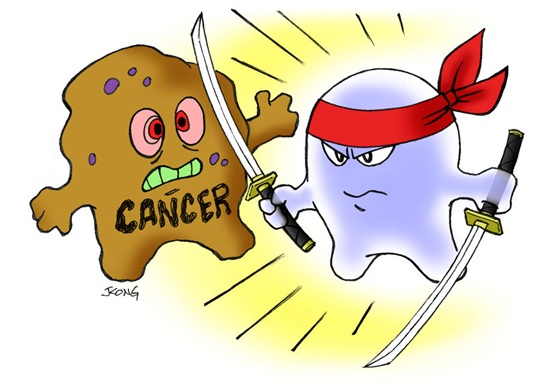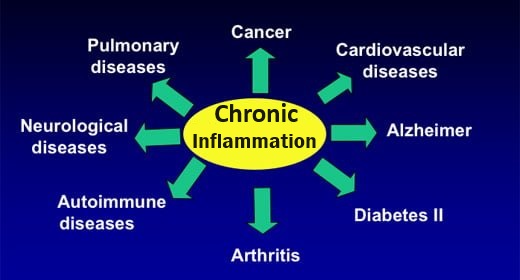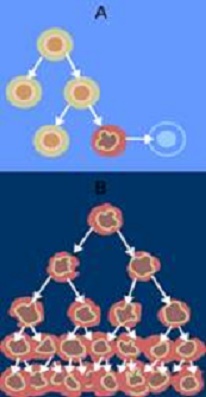Far from a death sentence, cancer is a wake-up call

What is a cancer cell?
A cancer cell is a normally aerobic cell turned anaerobic. A Nobel prize was given to Otto Heinrich Warburg in 1931 for this discovery. Cells become cancerous by becoming anaerobic due to lack of oxygen to fuel their mitochondrial aerobic energy production. (Note that not all cells use oxygen to create energy; E.g. Mature RBCs produce energy by anaerobic glycolysis).
A cancer cell inefficiently produces its energy by fermentation (from glucose), rather than by cellular respiration (from glucose + oxygen). It ferments glucose, hates oxygen and divides out of control. A tumor with a billion cells is about the size of the eraser on the end of a pencil.

Cancer incidence and death rates
Approximately 1 in 5 men or women develop cancer in a lifetime, and about 1 in 9 men and 1 in 12 women die from it.
Worldwide in 2022 – there were 20 million new cancer cases and 9.7 million people died of cancer. Lung cancer was the most frequently diagnosed cancer, accounting for 1 in 8 or 12.4% of all cancers (~2.5 million new cases). Percentages of other common cancer cases were female breast (11.6%), colorectum (9.6%), prostate (7.3%), and stomach cancer (4.9%).
Lung cancer caused the most cancer deaths (around 1.8 million /18.7%), followed by colorectal (9.3%), liver (7.8%), female breast (6.9%), and stomach (6.8%) cancers. Black people are twice as likely to die of prostate, stomach, and uterine cancers compared to white people.
Across the globe cancer rates differed up to 5-fold – from ~100 out of 100,000 in W. Africa to ~500 out of 100,000 in Australia / New Zealand. Bray F, Laversanne M, Sung H, Ferlay J, Siegel RL, Soerjomataram I, Jemal A. Global cancer statistics 2022: GLOBOCAN estimates of incidence and mortality worldwide for 36 cancers in 185 countries. CA Cancer J Clin. 2024 May-Jun;74(3):229-263. Epub 2024 Apr 4. PMID: 38572751.
Most common cancers in U.S. (2019)(> 40,000 cases, not counting | |||
Cancer type | Estimated yearly Cases | Estimated yearly DEATHS | 5-Year Survival rate (2008–2014)vs. people without cancer |
| Breast | Women: 268,600 Men: 2670 | Women: 41,760 Men: 500 | Women: 90% |
| Lung (incl. bronchus) | 228,150 | 142,670 Leading cause of cancer death | 23% |
| Prostate Slow growing, most common cancer in men | 164,690 | 29, 430 Leading cancer death in men | 98% |
| Colorectal (Colon, rectum) | 145,600 | 51,020 | 64% |
| Bladder Affects men more than women | 80,470 | 17,670 | 77% |
| Non-Hodgkin’s lymphoma Tumor develops from white blood cell lymphocytes | 74,200 | 19,970 | 71% |
| Kidney (Renal and Renal pelvis) | 73,820 | 14,770 | 75% |
| Endometrial (Most common of two uterine cancers) | 61,880 | 12160 | 84% |
| Leukemia (all types) Begins in blood-forming tissue of bone marrow. Abnormal white blood cells crowd out normal blood cells in blood and bone marrow. Impairs oxygen delivery to tissues, fighting infection and blood clotting. | 61,780 | 22,840 | 61.4% |
| Pancreatic (quickly spreads to nearby organs) | 56,770 | 45,750 | 9 % |
| Thyroid (Papillary, follicular, medullary) Anaplastic thyroid cancer, not included | 52,070 | 2,170 | Almost 100% |
| Liver and intrahepatic bile duct cancer (hepatocellular (most common), bile duct (cholangiocarcinoma), and hepatoblastoma) | 42,030 | 31,780 | 18 % |
Reference: The 13 Most Common Cancers with Statistics

By the time a tumor is diagnosed, it has usually been growing for several years.
We get cancer cells every day and our immune system normally destroys them
Lifestyle choices, lack of good nutrition, emotional trauma, exposure to toxins, microbial presence etc. create more fermenting cells than the immune system cells can handle . . . at which point we are diagnosed as having cancer.

To cure cancer, we need to understand that it is a systemic problem
Killing the cancer cells (with chemotherapy and radiation, for example) is not going to restore our system back to normal.
All cancers have five characteristics which need to be addressed (and made worse by conventional treatments, such as chemotherapy and radiation):
- Weak immune system
- Weak cell “battery” levels. Can involve,for example, low oxygen uptake by the cells, magnesium deficiency, poor cellular membrane integrity, harmful electromagnetic field (EMF) frequencies, or conversely, a lack of beneficial EMF frequencies;
- Microbial presence
- Excessive acidity in body tissues
- Imbalance of oxidants compared to “damage control” antioxidants

How does cancer start ?
Cancer begins when:
- More cancer cells are being created than . . .
- An overworked, depleted immune system can destroy.
Why is our immune system not strong enough to identify and eliminate new cancer cells? The weakening of the immune system is consequential to, for example:
- A diet of refined / over-processed food; minerally-depleted soils
- Toxicity, Microbes (parasites, viruses, bacteria, fungi) in the body.
- Harmful radiation / Lack of health-beneficial energy sources / electromagnetic frequencies (e.g. too much artificial light and not enough natural sunlight).
- Lack of sleep in a darkened room.
- Inactivity of the organs of elimination (e.g. lymph, lungs, liver, kidneys, skin, and bowels).
- Lack of exercise
Why the health problems? NEWSTARTS PLAN
The International Agency for Research on Cancer (IARC) and National Toxicology Program (NTP) report many carcinogens known to cause cancer in humans (here are some of the better known ones):
- Aflatoxins (produced by molds, especially Aspergillus species / fungi) e.g. in peanuts.
- Air pollution (and the particulate matter in it)
- Alcoholic beverages
- Asbestos (all forms) and mineral substances (such as talc or vermiculite) that contain asbestos
- Cadmium
- Coal, indoor emissions from household combustion
- Coal-tar pitch
- Diethylstilbestrol (DES)
- Engine exhaust, diesel
- Ethanol in alcoholic beverages
- Formaldehyde
- Iron and steel founding (workplace exposure)
- Leather dust
- Mineral oils, untreated or mildly treated
- Perfluorooctanoic acids (PFOAs). Found on some non-stick cookware and water-repellant fabrics
- Silica dust, crystalline, in the form of quartz or cristobalite
- Soot (workplace exposure of chimney sweeps)
- Talc containing asbestiform fibers
- Vinyl chloride
- Welding fumes
- Wood dust
Radiation
- X- and Gamma-radiation
- Ionizing (X- and gamma) and ultraviolet (UV) radiation
- Ultraviolet (UV) radiation, including UVA, UVB, and UVC rays
- Ultraviolet-emitting tanning devices
- Radioactive radioiodines, radionuclides, Radium-224 /-226 /-228, radon-222 and decay products
Viruses, bacteria, parasites, fungi
- Kaposi sarcoma herpesvirus (KSHV), also known as human herpes virus 8 (HHV-8) infection
- Hepatitis B or C virus (chronic infection)
- Human immunodeficiency virus type 1 (HIV-1) infection
- Human papilloma virus (HPV) types 16, 18, 31, 33, 35, 39, 45, 51, 52, 56, 58, 59 infection
- Epstein-Barr virus (EBV) infection
- Schistosoma haematobium (parasitic blood-dwelling fluke worms) chronic infection can cause bladder cancer, also associated with other cancers
- Opisthorchis viverrini (a liver fluke) infection (can cause cancer of the bile ducts)
- Helicobacter pylori infection
- Clonorchis sinensis (Chinese liver fluke) infection
Recreational Drugs
- Tobacco (smoke, smokeless, secondhand smoke)
- Alcohol
- Opium
Estrogen
- In menopausal therapy or oral contraception; also fat cells produce estrogen, a problem for those who are overweight.
Processed meat consumption.

Different cancers
Cancer varies in type and location. The most common cancers are lung, colon, rectum, and prostate.
Carcinomas – formed by epithelial cells (ECs), which cover inside and outside body surfaces – i.e. the skin and internal organs; ECs are often columnar in shape.
- Adenocarcinoma (most cancers of the breast, colon and prostate). Forms in ECs that produce fluids or mucus, Tissues with this type of EC are sometimes called glandular tissues.
- Basal cell carcinoma. Starts in the lower / basal / base layer of the epidermis (outer layer of skin).
- Squamous cell carcinoma (aka. epidermoid carcinoma). Forms in squamous cells – ECs that lie just beneath the epidermis, and also line many organs, including the stomach, intestines, lungs, bladder, and kidneys. Under a microscope, squamous cells look flat, like fish scales.
- Transitional cell carcinoma (some cancers of the bladder, ureters, and kidneys). Forms in a type of epithelial tissue called transitional epithelium, or urothelium. This tissue, which is made up of many layers of epithelial cells that can get bigger and smaller, is found in the linings of the bladder, ureters, and part of the kidneys (renal pelvis), and a few other organs.
Sarcomas – form in connective tissue – i.e bone, fibrous tissue (such as cartilage, tendons and ligaments), adipose tissue (fat), muscle, including muscle, fat, blood vessels, lymph vessels, and fibrous tissue (such as tendons and ligaments).
loose and dense forms (such as adipose tissue, tendons, ligaments, and aponeuroses) and specialized forms (such as cartilage and bone)
Leukemia – begins in the blood and bone marrow. They do not form solid tumors. Large numbers of abnormal white blood cells (leukemia cells and leukemic blast cells) build up in the blood and bone marrow, crowding out normal blood cells. The low level of normal blood cells can make it harder for the body to get oxygen to its tissues, control bleeding, or fight infections. There are four common types of leukemia, which are grouped based on how quickly the disease gets worse (acute or chronic) and on the type of blood cell cancer starts in (lymphoblastic or myeloid).
Lymphomas – start in the immune system’s T-cell or B-cell lymphocytes (a type of white blood cell). Abnormal lymphocytes build up in lymph nodes and lymph vessels, as well as in other organs of the body. There are two main types of lymphoma:
- Hodgkin lymphoma – Usually form from B-cells. Abnormal lymphocytes are called Reed-Sternberg cells.
- Non- Hodgkin lymphoma – can form from B cells or T cells. These cancers can grow quickly or slowly.
Melanoma (mostly on the skin, also in other pigmented tissues, such as the eye) – begins in cells that become melanocytes. These are specialized cells that make melanin (the pigment that gives skin its color). .


Malignant vs. benign tumors
Benign tumors (benign neoplasm) are not cancerous
- They are a proliferation of abnormal cells that stop growing by themselves, and which do not invade adjacent tissue or metastasize. They can be quite large, but usually do not grow back once removed, unlike malignant tumors, which sometimes return. Benign tumors can be life-threatening in the brain, where they can put pressure on adjacent areas.
- Pre-cancer. Benign, non-invasive tumors are also called pre-cancerous because they have the potential to progress to cancer (i.e. become invasive) if left untreated.

Malignant tumors
- Cancer (technically called malignant neoplasm) is a disease where cells lose control of their cellular reproduction capacity – rather than dividing in a controlled and programmed manner, the cells continue to divide and multiply abnormally. Number of divisions is not limited by telomeres on DNA (a counter system to limit number of divisions to 40-60).
- In most malignant cancers (except leukemia), cells form a detectable lump or tumor by invading and destroying adjacent tissue. Formation of large masses of tissue may lead to disruption of bodily functions by damaging organs or vital structures.
- The body tries to contain cancerous cells in their originally developed tissue (carcinoma in situ). E.g. the bladder lining or breast ducts (called superficial cancer growth). All body tissues have a layer (called a basement membrane) to keep its cells inside. If the cancer cells break through the basement membrane it is called invasive cancer.
- Angiogenesis. As a tumor grows bigger than a pin-head, its center gets further away from the blood vessels near where it is growing, preventing oxygen and other necessary nutrients from reaching it. To survive, it dispatches messengers (angiogenic factors) to promote the growth of new blood vessels and capillaries to supply its needs.
- Cancer cells can evade the immune system’s attempt to destroy these abnormal cells.One way they are able to “hide” from the I.S. is by surrounding themselves with a “cloak” made from protein.
Cancer is the leading cause of death worldwide killing nearly 10 million people in 2020 — nearly 1 out of every 6 deaths
Metastasis
Defined as the stage in which some cancer cells can break off from its source tumor to be transported through the bloodstream or lymphatic system to other places in the body and form new tumors. Cancer cell enzymes cut through tissue to enable cancer cells (and microbes) to spread to new areas via the bloodstream. Cancer cells produce and secrete millions of ENZYMES, which can destroy surrounding (extracellular) collagen and tissue, which would otherwise restrict the spread of cancer. Destructive cancer cell enzymes can eventually “cut” their way through the extracellular tissue to reach blood vessel walls through which the cancer cells may gain entrance to the blood stream. The “Rath Cellular Therapy” and sufficient thyroid hormone inhibit the degradation of connective tissue in the extracellular matrix (ECM).

Cancer cell properties
- The lifestyle of solid tumor cells requires variable degrees of adaptation to an hypoxic (low oxygen) environment. In low oxygen conditions, the much more efficient aerobic metabolism does not work well. Cancer cells adapt to their new way of life by a number of mechanisms, from membrane transport differences to variations in regulating the production of cellular ATP energy.
- Cancer cells have a competitive advantage over normal cells – the high rate of glucose consumption and concomitant release of acid may give tumor cells a competitive advantage over normal cells in the immediate environment.
Normal cells do not tolerate acid conditions very well. Tumor cells do;
Dividing cells require certain substances. The backbone for these crucial substances is derived from glucose metabolism. Also purines and pyrimidines to make nucleic acids (DNA, RNA), and coenzymes for energy production (Phospho-Adenosine compounds, such as. ATP, ADP , cAMP), NAD, NADP and FAD)
- It may not be possible to revert anaerobic cancer cells back to aerobic by simply supplying oxygen. Dr. Otto Warburg reported that even under aerobic conditions, tumor cells consumed glucose and produced lactic acid at exceptionally high rates. Note, however, that cancer cell can be destroyed by sufficient oxygen presence

PET, CT or MRI scans - Which ones give "True Picture" of cancer health?
A PET scan, not a CT or MRI scan, shows the “true Picture” of whether your cancer cells have been dealt with
- On CT and MRI scans, dead or necrotic cancer cells show up just the same as live cancer cells. This can therefore give a false diagnosis
- PET scans differentiate between live and dead cancer cells
The body eventually breaks down and eliminates dead cancer cells
CT scans estimated to cause 1.5 – 2% of cancer cases in U.S.
“According to a 2009 study in the Archives of Internal Medicine, CT scans alone will cause nearly 30,000 unnecessary cancer cases [every year] (about 2 percent of cancer cases), which will lead to about 14,500 deaths. But wait, there’s more bad news. While 30,000 cancer cases is a large number, a New England Journal of Medicine study from 2007 estimated that overuse of diagnostic CT scans may cause up to 3 million excess cancers over the next 20 to 30 years.
If you do have a CT or MRI scan, protect kidneys from radiation damage
Baking soda is used to protect kidneys from radiation damage from such as CT scans, MRIs and other radiological diagnostics or treatments
Baking Soda Protects Kidneys from Radiological / Chemotherapy damage and slows kidney diseases

References
Berrington de González A, Mahesh M, Kim KP, Bhargavan M, Lewis R, Mettler F, Land C. Projected cancer risks from computed tomographic scans performed in the United States in 2007. Arch Intern Med. 2009 Dec 14;169(22):2071-7. doi: 10.1001/archinternmed.2009.440. PMID: 20008689; PMCID: PMC6276814. PubMed
Brenner DJ, Hall EJ. Computed tomography–an increasing source of radiation exposure. N Engl J Med. 2007 Nov 29;357(22):2277-84. doi: 10.1056/NEJMra072149. PMID: 18046031. PubMed














